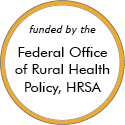Rural Project Examples: Behavioral health
Effective Examples
I Got You: Healthy Life Choices for Teens (IGU)

Updated/reviewed February 2024
- Need: To improve awareness of behavioral and mental health issues by students in rural, east central Mississippi.
- Intervention: An intensive community mental health outreach program was implemented for students in rural Mississippi.
- Results: As of 2018 and on a yearly basis, 6,000 7th and 8th grade students receive mental health education on a variety of topics which improves their ability to recognize mental health issues, high risk behaviors, and manage their own choices.
University of Vermont Medical Center's Nursing Home Telepsychiatry Service
Updated/reviewed December 2023
- Need: To improve the health status and access for rural nursing home patients in need of mental health services.
- Intervention: The University of Vermont Medical Center provides telepsychiatry care and education to nursing homes in communities that face shortages of mental health professionals.
- Results: These telepsychiatry consultations have eased the burden on nursing home residents by saving travel time, distance, and money it takes to travel to the nearest tertiary facility.
Promising Examples
Communities that Care Coalition
Updated/reviewed September 2025
- Need: To improve the health and well-being of young people in the rural area of Massachusetts's Franklin County and North Quabbin, and to reduce youth drug and alcohol use.
- Intervention: A community-based prevention coalition was formed to improve youth health and well-being and reduce youth drug and alcohol use. The coalition brings together stakeholders from across the community and uses the Communities That Care evidence-based community planning system.
- Results: CTC has seen significant reductions in substance abuse among local youth in the 30 rural towns they serve.
Schools That Care

Updated/reviewed September 2025
- Need: To provide mental health services to rural Kansas students and their families.
- Intervention: The Schools That Care project provides mental health treatment and case management as well as community education events.
- Results: From 2018 to 2021, 3,456 individuals participated in health education and counseling activities offered to the public, and 964 individuals and 303 families received direct services through the Family Advocate.
Health without Borders


Updated/reviewed January 2025
- Need: To improve the health of communities in the south central region of New Mexico.
- Intervention: A program was developed to address diabetes prevention and control, behavioral healthcare, and immunization in Luna County.
- Results: During the program, 1,500 immunizations were distributed, baseline measurements of participants improved, and 935 new patients were seen for behavioral health issues.
Nurse Navigator and Recovery Specialist Outreach Program

Updated/reviewed December 2024
- Need: To properly address and treat patients who have concurrent substance use disorders and chronic healthcare issues.
- Intervention: A referral system utilizes community health workers (CHWs) in a drug and alcohol treatment setting. A registered nurse helps with providers' medication-assisted treatment programs.
- Results: This program has reduced hospital emergency visits and hospital readmissions for patients since its inception.
Cross-Walk: Integrating Behavioral Health and Primary Care

Updated/reviewed May 2024
- Need: To address and treat substance use disorder (SUD) and depression in the Upper Great Lakes region.
- Intervention: Cross-Walk, a program that integrates behavioral healthcare into primary care services, was developed in Michigan's Marquette County.
- Results: The collaborative efforts strengthened care management services in local healthcare facilities as primary care patients were referred to a behavioral health specialist.
Contingency Management Smoking Cessation in Appalachia
Updated/reviewed June 2022
- Need: To reduce smoking rates of pregnant women and adolescents in Appalachian regions of eastern Kentucky and Ohio.
- Intervention: A web-based smoking cessation program that offered monetary incentives to reducing smoking.
- Results: Participants significantly reduced smoking rates or quit altogether.
Other Project Examples
Riverfront Talks: Substance Matters Podcast
Updated/reviewed December 2025
- Need: To reduce stigma around mental illness and substance use in North Carolina.
- Intervention: The Beaufort County Behavioral Health Task Force created the Riverfront Talks: Substance Matters podcast to interview people with lived experience.
- Results: As of December 2025, the podcast has 18 episodes.
CMH Addiction Recovery Program

Updated/reviewed November 2025
- Need: To help individuals and families impacted by substance use disorder access treatment and counseling in rural Missouri.
- Intervention: The CMH Addiction Recovery Program provides medication-assisted treatment, counseling, peer and family support, and other related services within a Rural Health Clinic.
- Results: The program operates 5 days a week and sees 400 patients each month.
For examples from other sources, see:
